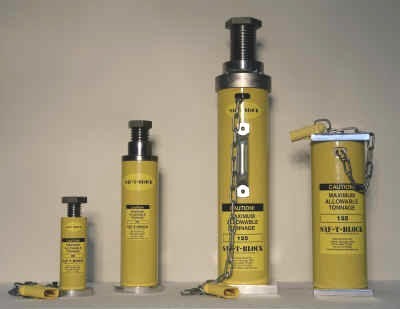Press Safety Blocks & Die Safety Blocks from Saf-T-Block
Safety Blocks are an OSHA requirement in the USA and need to be used whenever a press operator or setup or maintenance personnel have any body parts on or in the die or within the press platen area that could cause injury should the press activate. Proper procedures call for the use of die safety blocks in these instances, with the press locked-out.

Machine examples include
-
Mechanical presses
-
Hydraulic presses
-
Punch presses
-
Injection molding presses
-
Stamping & drawing presses
O.S.H.A. says, “The employer shall provide and enforce the use of safety blocks whenever dies are being adjusted or repaired in the press.” Saf-T-Blocks are available in a complete range of sizes to meet almost any requirement and are made from high strength 6061-T6 and T651 aluminum extrusions.
Feather-Weight Adjustable Safety Blocks
-
5-ton maximum static load capacity
-
Available in three sizes
-
Steel Holder and Electrical Cut-Off System also available
Light-Weight Adjustable Safety Blocks
-
35-ton maximum static load capacity
-
Safety Block length in 1 inch increments up to 60 inches
-
5 inches to 12 inches screw adjustment available
Mid-Weight Adjustable Safety Blocks
-
75-ton maximum static load capacity
-
Safety Block length in 1 inch increments up to 60 inches
-
5 inches to 12 inches screw adjustment available
Heavy-Weight Adjustable Safety Blocks
-
125-ton maximum static load capacity
-
Safety Block length in 1 inches increments
-
Standard screw adjustment is 5 inches
Standard Safety Blocks
-
Available in three different capacities and in five sizes to 250 tons
-
Lengths available from 4 inches to 92 inches
Saf-T-Block Options

Protective End Caps
Designed to prevent damage to safety press block that might reduce effective tonnage rating. These caps are strongly recommended on top and bottom.

Wedges (Aluminum or Hardwood)
Used to fill the gap between the safety press block and the upper slide (RAM). Aluminum is the most durable and much preferred, though hardwood is available.

Handles
Provides a safe method of handling safety press block. Two handles are highly recommended for longer blocks and heavyweight adjustable models.

Power Cut-Off System
In storage When the safety block is stored on the side of the press with the safety plug connected to the control circuit, the press is operative.
In use When the safety block is in the press bed area with the safety plug disconnected from the control circuit, the press is inoperative.
This system complies with OSHA Energy and CSA lockout regulations.
CSA Certified File No. LR6837
U.L. Certified File No. E46237

Holder
Safety press block holder provides a safe, designated place near the electrical connection. It is available for all our safety press blocks, including any accessories. The rubber retention strap is included.
Correct Block Length is Critical
Maximum .250″ of daylight. Under no circumstances should there be more space between the top of the Safety Block and the die, or between the top of the Safety Block and the slide or platen if the die is absent. It is absolutely critical to accurately calculate the needed length. An opening greater than .250″ changes the force of a moving slide from static to dynamic.
The Advantages of Aluminum
Many materials are available for use in blocking the ram and upper die of a press. However, 6061-T6 or T651 aluminum offers much higher extruded strength per cubic inch of material than other known press safety block materials on the market such as magnesium.
When the static load capacity of the material is compared, aluminum becomes the clear choice.
Use only certified material. Aluminum is malleable and will deform. Magnesium is supposed to fracture at a 45-degree angle but can fracture and cause shrapnel. Steel should never be considered due to potential shrapnel issues.
.250″ of daylight. Under no circumstances should there be more space between the top of the Die Safety Block and the die, or between the top of the Die Safety Block and the slide if the die is absent. It is absolutely critical to accurately calculate the needed Safety Die Block length. An opening greater than .250″ changes the force of a moving slide from static to dynamic.
